A taste for cheese
Researchers aim for cheese that is tastier, more nutritious, and easier to make than those now available.
By Emily Sohn
Chances are you love cheese. You might put cheddar on your crackers, Swiss on your sandwiches, or melted Colby on your hamburgers. You probably go gaga over a bowl of gooey mac and cheese and nuts over cheesy nachos. You eat pizza any chance you get.
“There really is no good excuse not to like cheese,” says Lloyd Metzger. He’s a dairy food chemist at the University of Minnesota, Twin Cities.
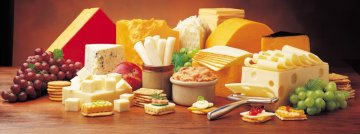 |
|
There’s a cheese to fit nearly any taste preference.
|
| © Copyright Midwest Dairy Association. All Rights Reserved. |
With thousands of varieties available and more in the works, there’s a cheese to fit nearly any taste preference, Metzger says. “If you like stinky cheese, you can find a cheese to fit that flavor profile,” he says. “If you like bland cheese, you can find that, too.”
Metzger has developed an especially fine appreciation for cheese. As a scientist who studies this multipurpose food, he makes and tastes cheese in his laboratory two or three times a week.
Along with other researchers around the world, Metzger is working to formulate cheeses that are tastier, more nutritious, or easier to make than those now in stores.
More than just your taste buds stand to benefit from cheese research. Cheese making is a big business, too.
Every year, each person in the United States eats an average of 33 pounds of cheese, according to data published by the Food and Agriculture Organization of the United Nations. Denmark, Greece, and France top the list, with 63, 57, and 54 pounds per person, respectively.
That’s a lot of cheese.
Making cheese
Loving cheese is nothing new. People have been making it for at least 5,000 years, maybe longer. The first cheese-makers, most experts agree, were herders in the Middle East who domesticated goats and sheep and figured out how to milk them.
Legend has it that someone once stored milk in a saddlebag made from the stomach of an animal. After a while, lumps developed in the milk, thanks to a stomach enzyme in the bag called rennet. Voilà! The first cheese was born.
Turning liquid milk into a solid food had advantages. Compared to milk, cheese was easy to transport, and it could be stored for a longer time. It also tasted good.
The basic process of making cheese hasn’t changed much since those first lumps accidentally formed thousands of years ago. Scale is probably the biggest difference.
Instead of using animal stomachs to process milk from a few homegrown cows, Metzger says, large cheese companies now use room-sized vats that hold 50,000 gallons of milk.
Once in the vat, milk is often heated to kill harmful bacteria. Manufacturers then add rennet, which is extracted from animal stomachs. Proteins in milk normally float around as separate molecules. Rennet makes them stick together.
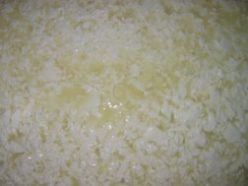 |
|
Adding rennet to milk causes proteins in the milk to coagulate into clumps, called curds, which can then be cut up into smaller pieces.
|
| Courtesy of Lloyd Metzger |
Within 30 or 40 minutes, the enzyme turns the milk’s proteins into gel-like yogurt clumps called curds. Stirring utensils and knives in a machine cut the curds into small pieces. As the mixture becomes more concentrated over the next 3 to 5 hours, a liquid called whey seeps out.
Companies use whey to make high-protein shakes and other products. For every 100 pounds of milk, 90 pounds of whey escape, leaving just 10 pounds of cheese to chew on. First, though, there’s still more work to do.
Bacterial cultures and salts go in next. The types that are added determine what kind of cheese you end up with. The variety of milk (including what kind of animal it comes from and what the animal was eating before it was milked) also makes a difference, as do storage conditions.
Swiss cheese, for instance, goes through a unique ripening process with a certain type of bacterial culture that generates gas, putting holes in the cheese. Cheddar cheese goes straight into the refrigerator. As the cheddar sits there, however, proteins break down, creating a “sharper” flavor. The longer it sits, the sharper the cheese gets. Sometimes, aging goes on for years.
Perfect melt
To dig deeper into the science of cheese, Metzger works with a special cheese-making machine. One of his main goals is to develop a mozzarella cheese that melts and stretches the way pizza makers would like it to. It’s a search for the “perfect melt.”
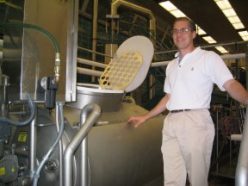 |
|
Lloyd Metzger and his cheese-making machine.
|
| Emily Sohn |
“One problem right away when you make mozzarella,” Metzger says, “is that it doesn’t have the texture that you want.”
When it’s freshly made, mozzarella cheese releases a lot of water when it’s heated, and it doesn’t melt into that stretchy, smooth blanket of chewy goodness sought out by pizza lovers far and wide. Only after about 30 days in the refrigerator does fresh mozzarella develop the properties you see in pizza ads.
If you’ve ever had fried cheese sticks that were watery, the problem might have been a batch of cheese that was too fresh. “The cheese sticks out of the breading, and it leaks all over,” Metzger says. “We want to prevent the cheese from having a lot of flow, but we still want it to have a big, long stretch.”
It’s the composition of the protein network in mozzarella that determines how stringy the product ends up, Metzger says. And proteins normally take time to break down.
So, Metzger and his colleagues are experimenting with different kinds of bacterial cultures that might help chop up these proteins more efficiently. They’re also working with concentrations of calcium, because the mineral acts like cement to hold the structure of cheese together.
“What we’re trying to do,” Metzger says, “is to change how we make mozzarella so it performs the way we want it to right away.”
Processed cheese
Metzger also works with processed cheeses. Kraft Foods started making these products in the 1920s, and they have grown more and more popular ever since. They were first developed as a food that could be safely shipped to soldiers overseas without spoiling.
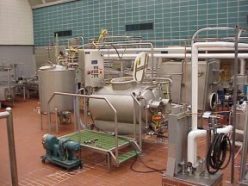 |
|
Computer-controlled machinery for making and studying cheese.
|
| Courtesy of Lloyd Metzger |
Foods such as Velveeta are made out of fresh cheese, but they’re heated and mixed with salts that turn the cheese into what’s called an emulsion. The result is a squeezable, free-flowing food that can last indefinitely.
The popularity of processed cheeses has created a growing demand for consistency. People want their cheese products to taste the same every time.
With so many factors involved, including milk that changes in flavor every season, creating tastes on demand can be a big challenge for cheese manufacturers. To meet these demands, Metzger and his colleagues use high-tech microscopes and other equipment to analyze how cheese proteins and fats interact in different concentrations.
The final product also depends on how much mixing occurs or what type of emulsion salts are added. During processing, “things are always changing,” Metzger says. “It’s a constant battle to keep things in spec.”
Work of art
At places such as the Northeast Dairy Foods Research Center at Cornell University in Ithaca, N.Y., and the California Dairy Foods Research Center in Davis, scientists are developing new ways to make low-fat cheese, new types of packaging to preserve cheese longer, cheeses that freeze well, better techniques for making cheese quickly and cheaply, and more.
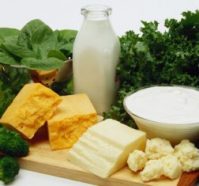 |
|
Milk, whether from cows, goats, sheep, or other animals, can be converted into all sorts of cheeses.
|
Yet, as scientific as the process has become, cheese-making in many places remains a work of art, designed to please the eye as well as the palate. On modest farms from France to Wisconsin, people tinker with small batches of fresh organic milk to make beautiful blocks of flavorful cheese that are different every time. Despite the costs, demand is high.
“For $20 a pound, you can have art and something special,” Metzger says. Or you can gnaw on a hefty chunk of cheddar for a fraction of that price. Thanks to science, there’s something for everyone.
Going Deeper:
News Detective: Emily Visits a Cheese Lab
Cheese Facts
Cheese consumption per person (by country), 2002
|
Country
|
Pounds
per year |
| Denmark |
63
|
| Greece |
57
|
| France |
54
|
| Italy |
49
|
| Germany |
43
|
| United States |
33
|
| Australia |
31
|
| Canada |
27
|
| United Kingdom |
22
|
| New Zealand |
18
|
| Spain |
15
|
| Mexico |
5
|
Source: UN/FAO, FAOSTAT Agricultural Database







